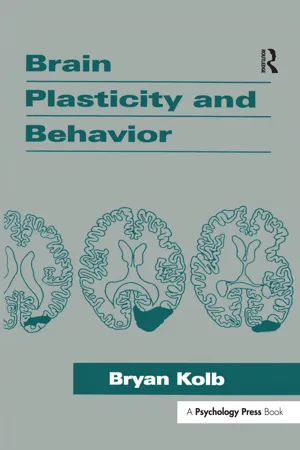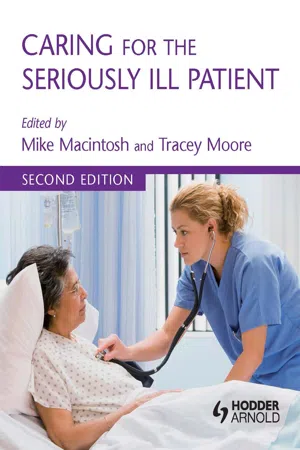Psychology
Neurological Damage on Behaviour
Neurological damage can significantly impact behavior by altering cognitive, emotional, and physical functioning. Damage to specific areas of the brain can lead to changes in personality, decision-making, and emotional regulation. Understanding the relationship between neurological damage and behavior is crucial for developing effective interventions and support for individuals with brain injuries or neurological conditions.
Written by Perlego with AI-assistance
Related key terms
4 Key excerpts on "Neurological Damage on Behaviour"
- eBook - ePub
- Hans Eysenck(Author)
- 2017(Publication Date)
- Routledge(Publisher)
A number of attempts have been made to relate individual differences in behaviour to neural processes theoretically, and in each of these the basic assumption has been that inter-individual behavioural variation is dependent to some extent upon the state or nature of the nervous system which each individual possesses. Observed behaviour in a given situation is thus dependent upon the efficiency with which the central nervous system functions, and hypothesized differences in the theoretical constructs equated with neurological efficiency are called upon to account for observed individual differences in performance. In the case of injury or pathology of the brain such neurological efficiency will be reduced, and corresponding changes and impairments of behaviour will be observed. There is, then, from such a theoretical position, the possibility of accounting for the behavioural effects of brain injury or pathology in terms of the operation of biological variables hypothesized to account for inter-individual variation in the non-brain-damaged population. Predictions can be made concerning the expected direction of behavioural changes following brain damage on the basis of the concept of reduced neurological efficiency, and it follows that empirical verification of such predictions can contribute to the status and validity of the theoretical constructs related to neurological efficiency upon which they were based.One example of how injury to the brain invariably produces some degree of impairment of behaviour is found in intellectual deterioration. From reviews such as those of Meyer (1960) and Yates (1966), we see that there is ample evidence in the literature to suggest that the disorganization of brain function through damage or pathology leads to some form of lowered efficiency in intellectual and cognitive abilities, which themselves differ with respect to efficiency within the general population. For a given brain-damaged individual, his present level of intellectual functioning will be dependent upon the extent of the disorganization of brain function and his level of ability prior to brain damage. That intellectual performance should be impaired to some degree by brain damage is not surprising, for the range of individual differences observed in intellectual and cognitive abilities is clearly related to a considerable extent to the general organization, efficiency, and integrity of cortico-neural processes. Considerations of this nature, in relation to intellectual functions, have tended to provide the model for subsequent attempts to demonstrate the interrelationship of all forms of inter-individual behavioural variation, the effects of brain damage, and hypothesized neurological processes, thus extending the generalizations to areas of personality and its biological basis. - eBook - ePub
- Bryan Kolb(Author)
- 2013(Publication Date)
- Psychology Press(Publisher)
Levin, Eisenberg, & Benton, 1989 ). Estimates of the number of people who have mild head injuries, without hospitalization, vary widely, but in the United States it is probably in the order of at least an additional 100,000 per year. An additional 100,000 people die from head trauma and are not included in most statistics. Overall, it appears that the frequency of closed head injuries in industrialized countries ranges from about 300 to 450 per 100,000 population per year. Projected over one’s life span, the chances of such an injury are high indeed. It has been estimated that a child’s chances of having a significant closed head injury are 1 in 30 before the child is old enough to drive! Similarly, it is estimated that there are about 400,000 new cases of stroke every year in the United States (about 1.3% of the population), and most surviving stroke victims experience significant cognitive loss. As the number of stroke survivors in the United States now approaches 2 million, we can begin to understand the strain on support services. When we add the toll from neurological diseases (e.g., Parkinson’s, Alzheimer’s) we reach a very high probability of having a behavioral disorder, or of having a close relative with a disorder, related to brain injury or disease. The estimate in the United States is that about 48 million people (or about 15%) have some sort of neurological disorder, exclusive of “mental diseases” such as schizophrenia, which is also clearly a result of neural dysfunction.The high incidence of brain injury and disease thus poses perhaps the most perplexing clinical neurological problem in the 1990s, which is the question of how to repair the damaged brain. Because recovery from brain damage is a practical example of brain plasticity, the incidence and processes of recovery are of considerable interest in the context of research on brain plasticity. Before one can investigate the relationship between brain plasticity and recovery of function, it is necessary to consider the conditions under which recovery is most likely to occur and to review the way in which functional recovery is measured. This chapter reviews (a) the methods of studying functional recovery in both human patients and laboratory animals and (b) the evidence of functional recovery in adult humans and laboratory animals. Recovery in the developing animal is reviewed in the next chapter.Studying the Broken Brain to Understand the Normal Brain
It may at first seem paradoxical that one would damage the brain in order to understand the nature of plastic processes of the normal brain. Indeed, it seems logical simply to study the plasticity of the normal brain as it learns new material or changes with experience. After all, if brain plasticity is responsible for behavioral change, then changes in the brain should be apparent when behavior changes in the normal person. This is a reasonable perspective, but there are some complications. In particular, there is the problem of knowing where to look for plastic changes in the billions of cells and trillions of synapses. Thus, practically, it is going to be necessary to study brain plasticity in situations in which we can expect large and unambiguous changes in particular locations and in which a time of onset can be specified. A fundamental assumption I am making, therefore, is that the easiest way to produce and to locate large changes in cerebral organization is to perturb the brain directly, and then to study the nature of the neural and behavioral changes that follow. This is the “sledgehammer” approach to studying behavioral change, but once we have found changes in brain and behavior it will be possible to try more subtle approaches. - eBook - ePub
- Walter R. Niessen, Michael Macintosh, Tracey Moore(Authors)
- 2011(Publication Date)
- Routledge(Publisher)
CHAPTER 4NEUROLOGICAL ASSESSMENT AND MANAGEMENT
Catheryne Waterhouse
Introduction Anatomy and physiology of the nervous system Blood supply of the brain Neurological assessment Caring for the unconscious patient Common neurological conditions Conclusion ReferencesLEARNING OUTCOMES
Upon completion of this chapter the reader will:1. have an understanding of the normal functioning of the neurological system and the impact pathophysiological changes through injury, disease or illness have on this system – and hence the patient2. have an understanding of the assessment needs of a patient with a neurological disorder or head injury3. be aware of the more common neurological disorders and injuries and the associated care and treatment of patients4. appreciate the impact of neurological injury and/or disease on patients and their families.Introduction
The aim of this chapter is to explore issues surrounding the care and treatment of patients exhibiting signs of neurological deterioration. Patients suffering from head injury, or other neurological episodes caused by disease or trauma, demand high levels of monitoring and observation, to decrease mortality and significantly reduce the likelihood of permanent brain injury and disability. This chapter focuses on some of the more common injuries and acute illnesses likely to be encountered.The nervous system is divided into central and peripheral parts. The central nervous system (CNS) is made up of the brain, its cranial nerves and the spinal cord. The peripheral nervous system is composed of spinal nerves that connect to the spinal cord, and the autonomic nervous system divided into sympathetic and parasympathetic parts (Martini and Bartholomew 1997).Anatomy and physiology of the nervous system
The brain is a hugely complex organ divided anatomically into the cerebrum, the cerebellum and the brainstem. Its primary functions are to monitor, integrate and process internal and external stimuli and respond appropriately. - eBook - ePub
- Julian Leslie(Author)
- 2015(Publication Date)
- Routledge(Publisher)
From a practical point of view, parallel investigations of behavioural and neurological aspects are highly desirable. There is endless public debate as to whether certain psychiatric disorders – for example, schizophrenia – are 'really' genetic or environmental in origin. It should become clear in this chapter that this question is misstated, because there will always be a range of biological and a range of environmental influences on any aspect of human functioning. One investigation might show strong evidence of genetic factors in a disorder (e.g., if family members sharing a certain gene show evidence of the disorder while family members without the gene do not show it), and another might show evidence of a strong environmental influence (e.g., if those members of a community subjected to severe stress show the disorder, while those not stressed do not). The solution to the apparent problem here is that certain investigative strategies reveal the influence of biological or neurological factors, while others reveal the influence of environmental factors. Which is more 'important' depends on our current concern. If it is possible, for example, to reduce the stress individuals suffer as a route towards reducing psychiatric disorder, then we will be most interested in the findings and implications of the study showing environmental effects. If, on the other hand, new developments in gene therapy suggest that a targeted drug treatment is feasible, then data from the family genetics study will be crucial. Finding an effective strategy will always be made more likely if both behavioural and brain processes are understood.In broad terms, behavioural neuroscience is the interdisciplinary field of study that seeks to use behavioural techniques to understand brain function, and to use techniques of neuroscience to elucidate behavioural processes. Psychology and neuroscience come together in various ways in this interdisciplinary field. We shall be concerned here with the contributions that have been made by behaviour analysis. This relatively narrow focus is relevant to this book, of course, but it is also justified by the considerable contribution that behaviour analysis has made in this area. In some of the sections in this chapter general strategies and techniques will be introduced, while other sections will give more detailed information on specific issues in behavioural neuroscience. With both these approaches, it should be possible for the reader to begin to frame an answer to the question 'What is behavioural neuroscience?' It should be realized that the examples given in this chapter are a small group from a huge number that could be included, as this field is developing very rapidly. A minimum of information will be given about basic neuroscience. More extensive introductory accounts are suggested in the 'Further reading' section at the end of the book.
Learn about this page
Index pages curate the most relevant extracts from our library of academic textbooks. They’ve been created using an in-house natural language model (NLM), each adding context and meaning to key research topics.



